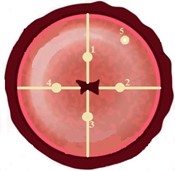Espectroscopia óptica de fluorescencia usando luz tipo LED en tejidos ex-vivo del cuello uterino.
Contenido principal del artículo
Realizar estudios de tejidos biológicos como el del cérvix con técnicas alternativas permiten dirigirse a un soporte al diagnóstico médico del cáncer de cuello uterino (CCU), el cuarto más común a nivel mundial y la primera causa de muerte en mujeres de 30-59 años en Colombia. En el tejido del cuello uterino se encuentran presentes diferentes fluoróforos como: NADH, flavina, elastina y colágeno; moléculas que generan fluorescencia gracias a su capacidad para absorber energía electromagnética, esto les permite emitir fotones de menor energía a una longitud de onda determinada. En las etapas iniciales de la displasia, las células cambian sus velocidades metabólicas, características físicas y estructurales; con esto se altera la respuesta espectral de las moléculas presentes en el tejido cervical. En la investigación se realizó el análisis de los espectros de fluorescencia utilizando luz LED ultravioleta en el rango de 335 a 340 nm cómo fuente de radiación electromagnética y se verificó que al interactuar en el tejido biológico de las biopsias del cuello uterino proporcionadas por el instituto caldense de patología de la ciudad de Manizales-Colombia, se generan espectros con respuestas activas en los rangos de las longitudes de onda de los fluoróforos evidenciando la interacción y excitación de los mismos. Dichos espectros son similares a los obtenidos con la espectroscopia óptica de fluorescencia tradicional aplicada con fuente de luz láser. Lo anterior permite concluir que utilizar la tecnología LED de más bajo costo que los láseres utilizados convencionalmente es viable para continuar con el procesamiento de los espectros del tejido del cuello uterino y generar una clasificación según su patología.
- Diodo emisor de luz (LED)
- Espectroscopia óptica de fluorescencia (EOF)
- Ultravioleta
- Cáncer de cuello uterino
- Fluoróforos
Ministerio de salud y protección social colombiano. Cáncer de cuello uterino [Internet]. Ministerio de salud y protección social. [citado el 14 de octubre de 2022]. Disponible en: https://www.minsalud.gov.co/salud/publica/ssr/Paginas/Cancer-de-cuello-uterino.aspx
Instituto nacional de salud (CO). 2018 jun [citado el 14 de octubre de 2022]. Disponible en:https://www.ins.gov.co/buscador-eventos/BoletinEpidemiologico/2018%20Bolet%C3%ADn%20epidemiol%C3%B3gico%20semana%2023.pdf
Ebenezar J, Aruna P, Ganesan S. Synchronous fluorescence spectroscopy for the detection and characterization of cervical cancers in vitro. Photochem Photobiol [Internet]. 2010;86(1):77–86. Disponible en: http://dx.doi.org/10.1111/j.1751-1097.2009.00628.x
Ramanujam N. Fluorescence Spectroscopy In Vivo. En: Encyclopedia of Analytical Chemistry [Internet]. Chichester, UK: John Wiley & Sons, Ltd; 2006. Disponible en: http://dx.doi.org/10.1002/9780470027318.a0102
Pradhan A, Pandey PK, Singh P. Overview of fluorescence spectroscopy and imaging for early cancer detection. En: Alfano RR, Shi L, editores. Neurophotonics and Biomedical Spectroscopy. Elsevier; 2019. p. 253–328
Giraldo BS. ESPECTROSCOPÍA ÓPTICA DE FLUORESCENCIA APLICADA AL SOPORTE DE DIAGNÓSTICO MÉDICO DE PRECÁNCERES DE TEJIDOS DE CUELLO UTERINO. [SEDE MANIZALES]: UNIVERSIDAD NACIONAL DE COLOMBIA; 2009.
Tiburcio Moreno J, Hernández F. ESTUDIO DEL PROCESO DE FOTODEGRADACION DE β-CAROTENO EN UNA SOLUCION DE TETRAHIDROFURANO (THF) USANDO ESPECTROSCOPIA DE ABSORCION OPTICA Y FLUORESCENCIA. CYD [Internet]. 30 de abril de 2019 [citado 14 de octubre de 2022];(20):12-5. Disponible en: https://revistas.unjbg.edu.pe/index.php/cyd/article/view/502
Lakowicz JR. Instrumentation for Fluorescence Spectroscopy. En: Principles of Fluorescence Spectroscopy. Boston, MA: Springer US; 2006. p. 27–61.
Sikorska E, Khmelinskii I, Sikorski M. Fluorescence spectroscopy and imaging instruments for food quality evaluation. En: Zhong J, Wang X, editores. Evaluation Technologies for Food Quality. Elsevier; 2019. p. 491–533.
Etcheverry ME, Pasquale MÁ, Garavaglia MJ. Caracterización del acoplamiento de una fuente de luz LED a una fibra óptica con aplicación en la terapia fotodinámica (TFD) del cáncer cérvix. En: III Jornadas de Investigación, Transferencia y Extensión de la Facultad de Ingeniería [Internet]. 2015 [citado el 14 de octubre de 2022]. Disponible en: http://sedici.unlp.edu.ar/handle/10915/47957
Álvarez AC, Corrés Sanz JM. Diseño y fabricación de fuente de luz blanca LED acoplada a fibra [Internet]. [PAMPLONA]: UNIVERSIDAD PUBLICA DE NAVARRA; 2001 [citado el 15 de octubre de 2022]. Disponible en: https://academica-e.unavarra.es/xmlui/bitstream/handle/2454/19114/TFG_Cilveti_Alvarez_Ander.pdf?sequence=1&isAllowed=y
Organización mundial de la salud. Cáncer cervicouterino [Internet]. Organización mundial de la salud. 2022 [citado el 14 de octubre de 2022]. Disponible en: https://www.who.int/es/news-room/fact-sheets/detail/human-papillomavirus-(hpv)-and-cervical-cancer
Pradhan A, Pandey PK, Singh P. Overview of fluorescence spectroscopy and imaging for early cancer detection. En: Neurophotonics and Biomedical Spectroscopy. Elsevier; 2019. p. 253–328 Disponible en: https://www.elsevier.com/books/neurophotonics-and-biomedical-spectroscopy/alfano/978-0-323-48067-3.
Ebenezar J, Aruna P, Ganesan S. Synchronous fluorescence spectroscopy for the detection and characterization of cervical cancers in vitro. Photochem Photobiol [Internet]. 2010;86(1):77–86. Disponible en: http://dx.doi.org/10.1111/j.1751-1097.2009.00628.x
Alfano RR, Yang Y. Stokes shift emission spectroscopy of human tissue and key biomolecules. IEEE J Sel Top Quantum Electron [Internet]. 2003;9(2):148–53. Disponible en: http://dx.doi.org/10.1109/JSTQE.2003.811285
Descargas

Esta obra está bajo una licencia internacional Creative Commons Atribución-NoComercial-CompartirIgual 4.0.
Los autores que publican en esta revista están de acuerdo con los siguientes términos:
Los autores ceden los derechos patrimoniales a la revista y a la Universidad del Valle sobre los manuscritos aceptados, pero podrán hacer los reusos que consideren pertinentes por motivos profesionales, educativos, académicos o científicos, de acuerdo con los términos de la licencia que otorga la revista a todos sus artículos.
Los artículos serán publicados bajo la licencia Creative Commons 4.0 BY-NC-SA (de atribución, no comercial, sin obras derivadas).









